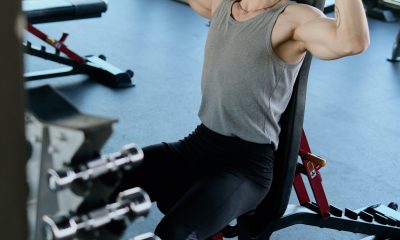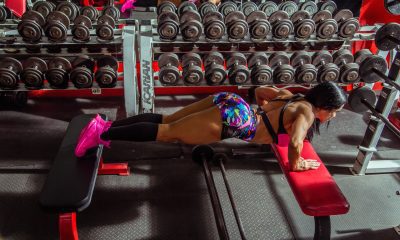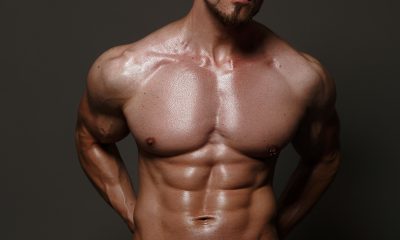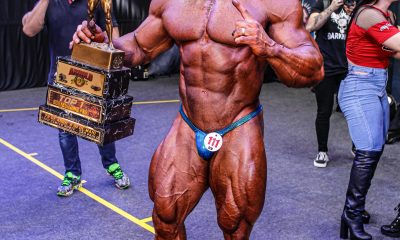Bodybuilding
How to Grow Muscle Mass as a Hardgainer
There are many people talking about not being genetically gifted and mentioning this fact as the main barrier to muscle gain process. That’s is why in this article we will talk about how to increase strength and mass in case of these people and will find the most appropriate exercises for this category.
This category of people is also called hard gainers, as they tend to have difficulties in putting muscle on them. But, the main issue that tons of these people use it as an excuse for their inability to quickly gain strength and muscle mass.
Most of them will tell you that they can not do it or they do not want to do it. these expressions are quite popular in their vocabulary. Also, they tend to put the success of other athletes on good genetics and chemistry. The truth is that about 98 percent of people training in the gym or home have no prone to muscle growth. So if you consider yourself a hard gainer, you are not in a minority.
The first thing you should do on the way to the results, it is to forget about the harmful idea that you possess some hidden problems with growth, which the rest of the world has consistently failed to notice it. You should start finally to tell yourself that you can do it or, better yet, you will do it.
If you are trained for a long period of time already, you know about the main rules that every hardgainer should follow:
- train very hard,
- train infrequently,
- use only with basic exercises,
- have a good rest between workouts
- eating large amounts and fully, especially places emphasis on quality sources of protein.
Must Read: 4 Meals with Most Protein to Take If You are Body Builder
Have to be mentioned that most training programs include only one approach in one exercise for individual muscle groups. Approaches are performed in large part by 6-12 repetitions to complete failure.
Further, you will see a typical training program for people not genetically gifted or, also called hard gainers. You can perform it twice a week, combined it with correct nutrition diet.
Must Read: How to Set up Your Own Bodybuilding Training Program
So, Here it is:
20 squats
10, up to 12 pullovers with a dumbbell
8 up to 10 bench press on an incline board
8-12 pulling or thrust block top
8-12 curls in the machine
8-12 extension arms to the block
Even it seems quite simple, this program perfectly fits many people. Be aware of the fact that you do 20 squats for real, with good breath, it will no doubt give some results in strength and weight gain. However, if you are one of these people who already tried this program and got no results, you have no reasons to worry about.
There are many other ways to get your lean muscle mass increased. You have to know that this program is probably one of the best for bulking and growing strength in the average athlete.
It involves a lot of ways of working, for example, the old-fashioned system of 5x5, heavy approaches for a couple reps and light, breathing approach, plus modern negative and partial repetition, and many other tricks. You have to be patient and use it for at least six-seven weeks. Only then you will see visible results of your hard work.
The program uses a triple-split, namely, the workouts are organized three times a week. If you find this exercise program too tiring for you, you can get more time for resting. Namely, you can take a pause of two days, after each exercises training.
Further, let’s see the specific of workout for chest and back. The workout for these body parts may be characterized as being essential and heavy, these elements being namely what every average athlete need in order to achieve great results.
First of all, start your exercises program with a ten minutes warm up the process. You have not to perform nothing heavy or complicated, just to raise the heart rate and warm up the muscles. For example, a short trip on a stationary bike or something like that. The warm-up stage is the same for all three workouts.
After warming up, start training with the bench press, this being one of the most common types of exercise. Start with a light warm-up approach by 10-15 times with a blank fingerboard. Take a pause of one or two minutes and make an approach to five times with a weight that you can lift ten times.
Must Read: The Benefits of Warm Up Exercises Before Workout
In case of approaches for working in the bench press, you need to use the scheme 5/4/3/2/1. Load on the neck weight with which you can do five reps, and make the first approach. After two to three minutes of rest, add weight to the bar, according to your weightlifting abilities, and perform 4 reps.
Must Read: How to Bench Press Properly?
After few minutes, add the same weight, let’s say for example 5 or 10 kg, and perform three repetitions. The next 2 approaches perform with the same weight for two and one repetitions. The main rule that has to be followed here is to increase the initial weight every week, little by little, at least for a kilogram.
Most of the bodybuilders are afraid to do one repetition approaches, considering that this is only characteristic for weightlifters, but this is not true. Further exercises in this workout program will be incline bench press. Comfortably set yourself under the bench and take two dumbbells, which weight would allow you to perform five reps. Then, put near to you two pairs of dumbbells, lighter and more easily.
For example, if the first pair of dumbbells has 30 pounds, then the second and third would have around 22 or even lower. The right way to perform this exercise is as follow: take the hardest weights, lie down, and perform five reps. Immediately after this, without taking any pause, take a middle pair of dumbbells and do five reps, then do the same thing with lowest weights.
You have to know that this method of execution has been always popular as a part of intensive training, especially in case of experienced bodybuilders. It was proved to be a very productive method to increase muscle mass and strength, but the golden rule does not overdo it. It will be quite sufficient to perform one such approach.

Next step would be a five-minute break after this would be the perfect time to train latissimus muscles.
For this purpose perfectly, will fit some solid traction movement, such as thrust rod to a belt or pull the tilt with a T-bar in the same method 5x5.
In case of this method you have to perform two approaches to warm up, five approaches with increasing load, and three sets with maximum weight. To be more clear, we will take an example. So, you can do thrust belt of five reps with a weight of 100 kilograms.
After this, your pyramid starts with 60 kg five times, then go to 80 kilograms, and five times on three business approach with a weight of 100 kilograms. In case of each operational approaches, you should try to do five reps.
When you can easily do five repetitions in the three approaches, it is necessary to lift weights. The type of system is quite simple, but it gives great results in muscle growth and strength.
Have to be mentioned that this is the only type of exercise back’ muscles.
As you know already, you have to take a five minutes before going further to another type of exercise. So, after you take this pause you have to perform heavy barbell shrugs. Here you will do five or even six approaches with one repetition.
Like in above case, weights have to be increased progressively during the exercise performing, beginning with the lowest and ending with the hardest one. It is very important here to understand that despite the exercise is performed using very heavy weight, the technique of execution must be accurate and correct.
Thus, always try to follow this recommendation: do each repetition to the bitter end, while lifting your shoulders as high as possible, clearly straining key stoning at the top of the movement and slowly lowering the weight down.
The second exercise program for increasing and strengthening the hip and lower back muscles. Like in case of first workout routine, you have to start your training with a warm-up stage. You can opt for a bike, and then do squats.
Squats are performed in the same manner as the draft in the previous exercise. The squat is considered a heavy type of exercise. That is why if in the latest approach, you would be able to perform two or three repetitions, that's will be very good.
Do the exercise in this mode as long as you can do with relative ease all three approaches, then you need to lift weights. Perform each exercise with accurate technique, deep enough - to the parallel thigh floor. Do not forget that the squat and deadlift which is the most productive of all the available exercises. For the average athlete is a great tool for mass-building.
After a five minutes break, dip exercises will be the next you will perform. Place the rack on a height to the whole of the range of movement you had to do the last 12-15 centimeters on the way up. In this exercise you are doing approaches with one repetition, so do five or six approaches to the ever-increasing load until you reach 95% of its maximum.
The third and final exercise in this exercise program is the deadlift with 20 repetitions. After a few warm-ups of light take a weight that you normally lift 10 times and do 20 reps with it. During each repetition should be done at least two deep breaths.
By the tenth repetition, you no doubt the need for five or six breaths. Deadlift is considered a very hard type of exercise, thus performing only one approach will be quite enough. In addition, it is a very effective exercise, so it must be performed by every man looking to increase muscle mass.
You will find on this blog a separate article about the benefits of deadlifts on building muscle mass. Also, you find there the right way of execution.
The Third Exercise Program is Meant for Building Arms and Shoulders Muscles:
Take the first step and perform a short warm-up exercise. Only after this, you may proceed to the training of hands using different techniques. The most useful exercises for building arms muscles are considered barbell curls and close grip bench press, both performed by the scheme 5/4/3/2/1.
Firstly you should perform two exercises without weights, doing for warming-up two approaches. Then hang on the bar weights for five reps, doing curls approach. After a break of few minutes, perform approach to five reps of close bench press grip.
So, you have to perform five sets, gradually increasing the weight on both rods. This is one of the most effective methods. After doing exercises for arms, you can go further to train deltas muscles. For this purpose are recommended standing chest press.
In the standing position in front of the squat racks, get them from the bar, and put them on the chest. Begin to perform jog presses, helping yourself to the initial phase through the movement of the legs.
Would be great to perform 4 approaches of bench presses till the complete failure.
First of all, add weight on the bar for eight repetitions. During the third approach, you have to do five reps, and no less than this. For diversification, the barbell can be lowered not only on the chest but over the head as well. But this hardly depends on the condition of your shoulder joints.
As you see the last type of exercise program looks easier than the above ones. Despite this, it has great effects on muscle growth. If you will combine these workouts with enough resting and qualitative food than in few weeks you will observe the results.
Also, enough resting will allow you to come to the gym in few days with and new power. Also, it is very important to notice that you have no to skip any workout, just because you are not in the right mood to exercise today. Perseverance is the key to build an attractive muscular body!
Bodybuilding
Understanding Trenbolone-Induced Cough (“Tren Cough”)

Trenbolone, a potent anabolic steroid, can sometimes cause “tren cough”—a sudden and intense coughing episode shortly after injection. Although not exclusive to Trenbolone, it is more commonly associated with this substance due to its highly irritant nature.
 Click Here To Buy 1-Test Cyp 100 by Nakon Medical
Click Here To Buy 1-Test Cyp 100 by Nakon Medical
Mechanisms Behind Tren Cough
Solvent and Carrier Irritation
Trenbolone formulations often include volatile solvents like benzyl alcohol or benzyl benzoate, which may irritate lung tissues when absorbed quickly into systemic circulation.
Prostaglandin Release
Trenbolone promotes increased production of prostaglandins, particularly PGF2α. This compound triggers contraction in the smooth muscles of the lungs, leading to bronchoconstriction and coughing.
Micro-Oil Embolism
Tiny oil droplets from an injection can reach capillaries and travel to the lungs, causing mild embolic reactions that lead to temporary oxygen deprivation and coughing.
Histamine and Mast Cell Activation
For some individuals, Trenbolone triggers histamine release and mast cell activation, mimicking an allergic response and causing bronchospasms and cough reflexes.
Related Article: Best Syringes for Steroid Injection on Amazon
Using Salbutamol (Albuterol) to Manage Tren Cough
- Salbutamol, a widely-used β2-adrenergic receptor agonist, can alleviate tren cough symptoms by:
- Relaxing bronchial muscles, easing spasms that cause coughing.
- Inhibiting prostaglandin effects, reducing bronchoconstriction associated with PGF2α.
- Opening airways, preventing severe respiratory restrictions in susceptible individuals.
Application Methods
Inhaler (Optimal)
Take 1–2 puffs of salbutamol (100–200 mcg) 5–10 minutes before a Trenbolone injection. If coughing occurs afterward, additional puffs can swiftly resolve the issue.
Oral Tablets (Moderate)
Consuming 2–4 mg tablets 30–60 minutes before injection offers slower, longer-lasting relief but may be less effective than inhalation methods.
Nebulizer (Severe Cases)
For individuals with frequent episodes, nebulized doses of 2.5 mg salbutamol can provide substantial relief.
Preventive Measures to Reduce Tren Cough Risk
- Inject slowly to minimize systemic absorption and irritant effects.
- Split doses to lower reaction severity with smaller quantities.
- Opt for ventrogluteal injection sites, which have fewer blood vessels, reducing oil embolism risk.
- Choose lower-concentration solutions to lessen irritation, as higher concentrations (e.g., Tren Ace 200 mg/ml) are more likely to provoke reactions.
What Other Steroids Can Induce Coughing?
Here's a curated list of peptides, SARMs, and PEDs that may potentially cause coughing or respiratory irritation in bodybuilders and fitness enthusiasts:
Peptides
IGF-1 LR3 (Insulin-like Growth Factor): Known for its anabolic effects, IGF-1 LR3 can occasionally cause mild respiratory irritation due to systemic absorption.
TB-500 (Thymosin Beta-4): While rare, improper injection techniques or high doses may lead to transient coughing episodes.
GHRP-6 (Growth Hormone-Releasing Peptide): This peptide can stimulate histamine release, potentially leading to bronchospasms and coughing.
SARMs (Selective Androgen Receptor Modulators)
RAD-140: (Testolone) Some users report throat irritation or coughing, often attributed to solvents used in liquid formulations.
YK-11: Known for its myostatin-inhibiting properties, YK-11 may cause mild respiratory discomfort in sensitive individuals.
LGD-4033 (Ligandrol): Though uncommon, some users experience coughing due to carrier solvents or allergic-like reactions.
PEDs (Performance-Enhancing Drugs)
Boldenone Undecylenate (Equipoise): This injectable steroid can cause “Equipoise cough,” similar to tren cough, due to oil embolism or irritant solvents.
Testosterone Suspension: The water-based formulation may lead to coughing episodes if injected improperly or absorbed rapidly.
Nandrolone Decanoate (Deca-Durabolin): While less common, coughing can occur due to histamine release or systemic irritation.
More Tips to Minimize Coughing Risks
- Use proper injection techniques to avoid embolic reactions.
- Opt for lower-concentration solutions to reduce irritant effects.
- Consider antihistamines or bronchodilators for individuals prone to respiratory sensitivity.
Read More: Joint Stiffness: How to Manage It While on AAS
Are There Alternatives to Cough-inducing Steroids?
Here are some alternatives to cough-inducing steroids that can provide similar anabolic effects while minimizing respiratory irritation:
Peptides
IGF-1 LR3 (Insulin-like Growth Factor)
Promotes muscle growth and recovery without the irritant properties of certain steroids.
TB-500 (Thymosin Beta-4)
Enhances tissue repair and reduces inflammation, making it a safer option for recovery.
BPC-157 (Body Protection Compound)
Known for its healing properties, it supports muscle repair and joint health.
SARMs (Selective Androgen Receptor Modulators)
RAD-140 (Testolone)
Provides significant muscle-building effects with fewer systemic side effects compared to traditional steroids.
LGD-4033 (Ligandrol)
Boosts lean muscle mass and strength without the risk of respiratory irritation.
MK-677 (Ibutamoren)
Stimulates growth hormone release, aiding in muscle growth and recovery.
Natural Alternatives
Turkesterone
A plant-based ecdysteroid that supports muscle protein synthesis and recovery.
Ecdysterone
Another natural compound that mimics anabolic effects without the harsh side effects.
Creatine Monohydrate
Enhances strength and muscle mass through improved energy production during workouts.
Other Options
Human Growth Hormone (HGH)
Promotes muscle growth and fat loss, though it requires careful monitoring due to potential side effects.
Testosterone Boosters
Natural supplements like D-Aspartic Acid or Tribulus Terrestris can help optimize testosterone levels for muscle growth.
SARMs Alternatives
Legal and safer versions of SARMs are available, offering similar benefits without the risks associated with traditional SARMs.
Overall
We have explored the phenomenon of "tren cough," a sudden, intense coughing episode often caused by Trenbolone injections due to factors like solvent irritation, prostaglandin release, micro-oil embolism, or histamine activation. Preventive measures such as using salbutamol (via inhaler, oral tablets, or nebulizer), injecting slowly, splitting doses, and opting for lower-concentration solutions were highlighted.
Additionally, alternative compounds to tren cough-inducing steroids were discussed, including peptides like IGF-1 LR3 and TB-500, SARMs such as RAD-140 and LGD-4033, and natural options like Turkesterone, ecdysterone, and creatine. These alternatives provide anabolic effects while minimizing respiratory side effects. The conversation also underscored the importance of proper injection techniques and thoughtful compound selection to reduce risks.
Bodybuilding
Mastering Bodybuilding in 2025: Top Fitness Tips for Success

Bodybuilding is more than just a sport; it's a lifestyle that requires dedication, discipline, and a thorough understanding of fitness principles. As the world of fitness continues to evolve, bodybuilders must stay updated with the latest trends, techniques, and scientific advancements to achieve their goals. In 2025, several innovative approaches are redefining bodybuilding. Here are essential fitness tips for bodybuilders to excel this year.
Read More: Bodybuilder Winter Clothing: Staying Warm and Stylish
Embrace Technology-Driven Workouts
In 2025, technology plays a significant role in bodybuilding. Wearable devices, fitness apps, and virtual reality (VR) training are now integral components of an effective workout regimen.
Wearable Devices
Modern wearables track everything from heart rate and sleep patterns to muscle activation and caloric expenditure. Utilize these devices to monitor your progress and make data-driven adjustments to your training and nutrition plans.
Fitness Apps
Leverage fitness apps for customized workout plans, progress tracking, and virtual coaching. Many apps now incorporate artificial intelligence to provide personalized feedback and recommendations.
Virtual Reality Training
VR technology offers immersive workout experiences, allowing bodybuilders to simulate different training environments and scenarios. This can enhance motivation and add variety to your routine.
Focus on Functional Strength
While hypertrophy (muscle growth) remains a primary goal, functional strength is gaining importance. Functional strength training improves overall performance, reduces the risk of injury, and enhances daily activities.
 Check Out Our1 4 Weeks Quality Strength & Lean Muscles
Check Out Our1 4 Weeks Quality Strength & Lean Muscles
Compound Movements
Incorporate compound exercises like squats, deadlifts, and bench presses. These movements engage multiple muscle groups and joints, promoting balanced strength development.
Core Stability
Prioritize exercises that strengthen the core, such as planks, Russian twists, and leg raises. A strong core supports better lifting mechanics and reduces the risk of lower back injuries.
Optimize Nutrition for Muscle Growth and Recovery
Nutrition is the cornerstone of successful bodybuilding. In 2025, the focus is on personalized nutrition plans tailored to individual needs and goals.
Protein Intake
Ensure adequate protein intake to support muscle repair and growth. Aim for 1.6 to 2.2 grams of protein per kilogram of body weight per day, depending on your training intensity and goals.
 Click Here to Buy SynthaTrope By SynthaPharma
Click Here to Buy SynthaTrope By SynthaPharma
Nutrient Timing
Pay attention to nutrient timing to maximize muscle recovery and growth. Consume protein and carbohydrates within 30 minutes post-workout to replenish glycogen stores and kickstart muscle repair.
Supplements
Utilize supplements wisely. Creatine, branched-chain amino acids (BCAAs), and omega-3 fatty acids are popular choices for enhancing performance and recovery.
Prioritize Mental Health and Mindfulness
Mental health is increasingly recognized as a critical component of overall fitness. Incorporating mindfulness practices can improve focus, reduce stress, and enhance performance.
Meditation
Incorporate meditation into your daily routine to reduce stress and improve mental clarity. Mindfulness meditation can enhance your mind-muscle connection during workouts.
Visualization
Use visualization techniques to mentally rehearse your workouts. Visualizing successful lifts and achieving your goals can boost confidence and motivation.
Rest and Recovery
Prioritize rest and recovery to prevent burnout and overtraining. Ensure you get 7-9 hours of sleep per night and incorporate rest days into your training schedule.
Leverage Advanced Training Techniques
Advanced training techniques can help break through plateaus and stimulate muscle growth. In 2025, several methods are gaining popularity among bodybuilders.
Blood Flow Restriction (BFR) Training: BFR involves restricting blood flow to the muscles during low-intensity exercises. This technique can enhance muscle growth and strength without the need for heavy weights.
Eccentric Training: Focus on the eccentric (lowering) phase of exercises. Eccentric training can stimulate greater muscle damage and growth compared to traditional concentric movements.
Periodization: Implement periodization into your training plan. Varying the intensity, volume, and type of exercises can prevent plateaus and ensure continuous progress.
Incorporate Recovery and Mobility Work
Recovery and mobility are essential for preventing injuries and maintaining optimal performance. In 2025, bodybuilders are paying more attention to these aspects of training.
Foam Rolling and Myofascial Release: Use foam rollers and massage balls to release muscle tightness and improve flexibility. Regular myofascial release can reduce soreness and enhance recovery.
Stretching: Incorporate dynamic stretching before workouts and static stretching after workouts. Stretching improves range of motion and prevents muscle imbalances.
Cryotherapy and Hydrotherapy: Explore recovery techniques like cryotherapy (cold therapy) and hydrotherapy (water therapy) to reduce inflammation and accelerate muscle recovery.
Engage in Continuous Learning and Community Building
The fitness industry is constantly evolving, and staying informed is crucial for success. Engage in continuous learning and connect with the bodybuilding community for support and motivation.
Educational Resources: Read books, watch videos, and attend seminars to stay updated on the latest research and trends in bodybuilding.
Community Engagement: Join online forums, social media groups, and local bodybuilding clubs. Sharing experiences and knowledge with fellow bodybuilders can provide valuable insights and encouragement.
Professional Guidance: Consider working with a certified personal trainer or coach. Professional guidance can help you optimize your training and nutrition plans, ensuring you're on the right track.
With your FB Plus subscription or active FB Plus Pass, you now have access to 124 weeks of our most popular workout programs, which typically sell for $10-$30 each. Additionally, our popular 4-week Meal Plan is included. This is on top of the 38 Challenges and Programs that are already available to Plus members.
We've also introduced a new feature that many of you have requested. To assist you in choosing your next program, you can now preview each day of any program from its detail view. This feature lets you see all the included workout videos and content before you schedule it, ensuring you know exactly what to expect.
Conclusion
In 2025, bodybuilding is more than just lifting weights; it's a holistic approach to fitness that encompasses technology, nutrition, mental health, and advanced training techniques. By embracing these fitness tips, bodybuilders can achieve their goals, stay injury-free, and enjoy a fulfilling fitness journey. Remember, consistency and dedication are key to success in bodybuilding. Stay committed, keep learning, and most importantly, have fun on your path to becoming the best version of yourself.
Bodybuilding
Top Video Games for Bodybuilders in 2025

There are several video games that can be great for bodybuilders, combining fitness and fun! Here are some of the best options:
Ring Fit Adventure (Nintendo Switch)
The game uses the Ring-Con and Leg Strap to guide you through various exercises and adventures. It's a fun way to get a full-body workout while playing a game.
Fitness Boxing 2: VR Boxing Remastered (PlayStation VR)
It offers a full-body boxing workout with a variety of punches and combos. It's a great way to improve your fitness while enjoying a virtual boxing experience.
Must Read: Marvel-Inspired Training Clothing on Amazon
Just Dance 2024
This popular dance game gets you moving to the beat with a variety of songs and dance routines. It's a fun way to burn calories and improve your coordination.
Zumba Fitness
Burn It Off (Nintendo Wii): This game offers a fun and energetic Zumba workout, perfect for those who enjoy dancing and want to get a good cardio workout.
Yoga for Beginners
If you're looking for a more relaxing workout, yoga games can help improve flexibility and reduce stress. Many of these games offer guided yoga sessions that you can follow along with.
Gym Tycoon
This game lets you build and manage your own gym, complete with various workout equipment and fitness classes. It's a great way to learn about different exercises and how to create effective workout routines.
The Sims 4: Fitness Stuff Pack
This expansion pack for The Sims 4 adds fitness equipment and activities to the game, allowing you to improve your character's fitness and join the athlete career.
Grand Theft Auto: San Andreas
While not a traditional fitness game, this classic game includes bodybuilding activities that can help your character gain muscle and improve fitness.
Knockout Home Fitness (Nintendo Switch)
This game offers a variety of boxing workouts that can help improve your strength and endurance.
Gym Simulator 24 (PC)
In this simulation game, you can build and manage your own fitness empire, creating workout routines and managing gym equipment.
Let's Get Fit (Nintendo Switch)
This game focuses on pure workouts, allowing you to set programs and follow along with digital trainers for a customized fitness experience.
Beat Saber (VR)
A popular VR game where you slash blocks to the beat of the music, providing an intense full-body workout.
Synth Riders (PlayStation VR)
This game combines freestyle dance and fitness, offering high-tempo tracks and multiplayer modes for a fun and energetic workout.
Yoga Master (PlayStation)
Designed by professional yoga coaches, this game offers a variety of yoga lessons and poses to improve flexibility and reduce stress.
Les Mills Bodycombat (PlayStation VR)
A martial arts-inspired workout game with a range of workout plans and coaching to keep you motivated.
OhShape Ultimate (PlayStation VR)
This game provides a full-body cardio workout with six sessions and two difficulty levels, designed to engage every part of your body.
These games offer a mix of cardio, strength, and flexibility workouts, making them great additions to your fitness routine.
Related Article: Supplemental Breast Milk for Bodybuilders
-

 Steroids2 years ago
Steroids2 years agoShavers and Other Body Grooming Equipment for Bodybuilders In 2023
-

 Steroids2 years ago
Steroids2 years agoChatGPT and Other Avenues to Find Great Bodybuilding Coaches
-

 Steroids2 years ago
Steroids2 years agoBest Oil Recommendations Before Competition for Subtle Shimmer
-

 Steroids2 years ago
Steroids2 years agoPowerlifting Vs Power Building: Find Out the Big Difference and When to Shift Between the Two
-

 Nutrition1 year ago
Nutrition1 year agoEverything Nutritional Food: What’s Too Much Or Too Little
-

 Bodybuilding Products1 year ago
Bodybuilding Products1 year agoTelmisartan In Bodybuilding: An Expert’s Advice
-

 Anabolic Steroids1 year ago
Anabolic Steroids1 year agoLegality of Anabolic Steroids In Latin America
-

 Beginners2 years ago
Beginners2 years agoTren Cycle for Beginners
-

 Bodybuilding1 year ago
Bodybuilding1 year agoList of FDA-Approved Peptides
-

 Bodybuilding2 years ago
Bodybuilding2 years agoCompetition Prep Cycle for Pro Bodybuilders
-

 Bodybuilding1 year ago
Bodybuilding1 year agoChia Seeds in A Bodybuilder’s Diet: An Expert’s Advice
-

 Bodybuilding7 months ago
Bodybuilding7 months agoPrimal Movements: Our Ultimate Guide for Maximum Results
-

 Steroids11 months ago
Steroids11 months agoAnadrol Cycle: Benefits, Doses, Alternatives, etc.
-

 Anabolic Steroids9 months ago
Anabolic Steroids9 months agoJoint Stiffness: How to Manage It While on AAS
-

 Anabolic Steroids11 months ago
Anabolic Steroids11 months agoHow Much Do You Know About B-AET? A Fat Burner You’ve Been Missing
-

 Steroids9 months ago
Steroids9 months agoOmnitope (Oxytocin)
-

 Bodybuilding1 year ago
Bodybuilding1 year agoHow Much Is Too Much Cardio? Understanding Heart Rate Zones
-

 Bodybuilding8 months ago
Bodybuilding8 months agoHow Effective is Bone Broth for Recovery?
-

 Product Reviews11 months ago
Product Reviews11 months agoTop Vitamins for Skin Health
-

 Steroids8 months ago
Steroids8 months agoSleeping Positions for Effective Muscle Recovery
-

 Steroids10 months ago
Steroids10 months agoMajor Bodybuilding Peptides Explained
-

 Bodybuilding1 year ago
Bodybuilding1 year agoCalorie Dumping: A Bodybuilder’s Guide
-

 Bodybuilding9 months ago
Bodybuilding9 months agoHormone Replacement Therapy (TRT) Cycle Guide
-

 Anabolic Steroids1 year ago
Anabolic Steroids1 year agoStart The New Year Strong With These Tips
-

 Bodybuilding10 months ago
Bodybuilding10 months agoHere Is How To know Your MRV (Maximum Recoverable Volume)




























